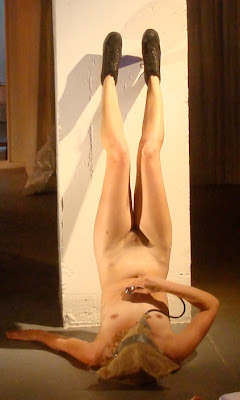
Stemma
Ursula Brookbank, Betsy Davis, Jessica Dolence,
Park McArthur, Alyce Haliday McQueen, Angela Simione,
Lisa Wiscombe and Liz Young
Curated by Launa Bacon and Cindy Rehm
November 11 - December 3, 2011
Opening reception: Friday November 11, 7-9pm
Closing: Saturday December 3, 7-9pm
929 North Oakland Ave, Pasadena, CA 91104
Open by appointment only, contact: craftswomanhouse@gmail.com
Craftswoman House is honored to present Stemma, a group exhibition featuring the work of Ursula Brookbank, Betsy Davis, Jessica Dolence, Park McArthur, Alyce Haliday McQueen, Angela Simione, Lisa Wiscombe and Liz Young. The exhibition will run from November 11 to December 3, with a closing featuring Bloodlines, an evening of video and performance from 7-9pm.
A stemma is a recorded genealogy of a family, or a family tree. The works included in Stemma reference the history of feminist art, and all of these artists can be seen as the progeny of second-wave feminism. Like the matriarchs of the second-wave, these artists make work that reflects women’s lives and experiences. They explore subjects of gender, identity, domestic life, and the female body, through video, painting, sculpture, and text.
See images from the opening
here.
Ursula Brookbank will present SHE WORLD, a continuing accumulation of relics and ephemera from the lives of women. Many of the items of feminine detritus are culled from the inhibiting post WWII era. Others reveal a woman’s effort for self-expression through arts, crafts, and homemaking. The archive creates an environment for the contemplation of the private histories that are contained within these artifacts of women’s daily lives.
http://www.ursulabrookbank.com
Along with her plastic sculptures, Betsy Davis will display her photographic series, Menstruation as a Glorified Event, a collaboration with Niels Alpert. Davis finds that menstruation has been seen in the media as something unclean or bothersome. In these images, Davis makes the act of bleeding sexy and alluring through visual stylization and as she celebrates a woman’s ability to procreate.
www.queenofplastics.com
Jessica Dolence’s work often shows a female character in an isolated and eerie place. Her digitally constructed animations are super-saturated and nostalgic of toys made for little girls. Her video installation, The Dying Room features a young Medusa who is seduced by the glow of a television. Dolence sets the work in a living room, originally the parlor where families mourned their deceased. Her characters are old monsters whose identity was formed out of fear.
www.jessicadolence.com
With her text-based pieces, Park McArthur questions the ways personal mobility is tied to social and political movements. These works filter lived experience through theories and practices of feminism, disability justice movements, and queer communities. Second-wave feminist art's commitment to personal lived experience as a platform for creative work grounds and guides her artistic practice.
www.parkmcarthur.com
In her video, I Love The Nightlife, Alyce Haliday McQueen uses dark humor to question expectations placed upon women in public and private life. She explores the myth of the modern super-woman who must maintain her composure under constant scrutiny of the male gaze.
www.alycehalidaymcqueen.com
Angela Simione examines the personal as political in her use of traditional craft as a means of diary keeping. Simione states, “For it is still radical for a woman to speak about her own experience of the world, and it is still unseemly for a woman to speak a certain way in public. It is still unwelcome, still threatening for a woman to honestly and intimately discuss her own life as a subject worthy of interest and investigation. This, as an assertion of worth, stands in direct opposition to the Status Quo. It is still discursive, still divisive, still upsetting. It is a voice that many people still choose to deride, make fun of, or simply ignore. Even private texts as seemingly innocuous as a diary are viewed with suspicion and the keeper often scoffed at or viewed as secretive and untrustworthy.”
http://angelasimione.weebly.com/
Lisa Wiscombe will present a tile installation inspired by Victorian floral patterns. This work continues her Spreads series, which features pornographic imagery that is embedded into the banal surface of the domestic environment. She poses the question, “If walls could speak, what would they say?”
http://www.lisawiscombe.com/
Liz Young’s practice incorporates a diverse range of materials, from industrial goods to household ephemera. She often explores issues of the flesh in relation to the human body and the natural world. With her recent series of tiny meat paintings, Young references domestic duties, as well as the miniature foods produced for dollhouses. The works are visceral, but also disarming due to their intimate scale.
http://www.youngproduce.com
image:
I Love the Nightlife, video still, Alyce Haliday McQueen, 2011







